How this Washington designer is turning her antiques obsession into an e-commerce venture
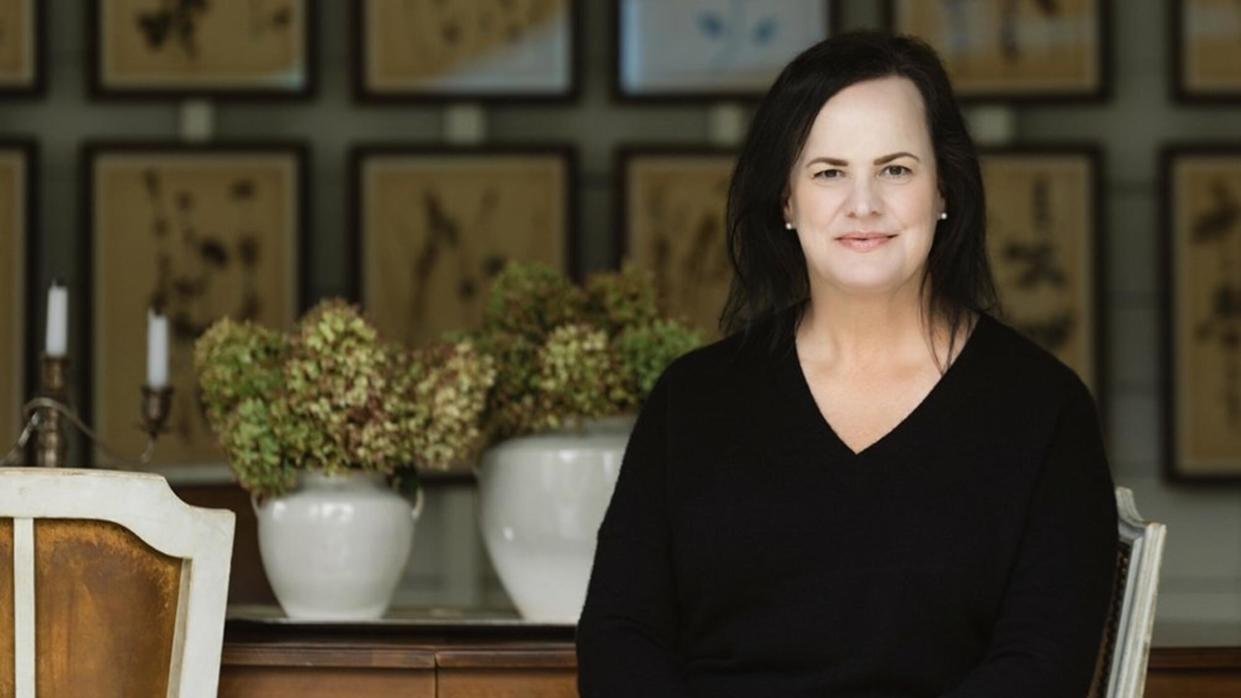
50 States Project | Dec 8, 2023
The 50 States Project is a series of candid conversations with interior designers across the country about how they’ve built their businesses. This week, Seattle-based designer Marianne Simon tells us how she found her historical design niche in a modern market, why she moved back to Seattle after a year in Charleston, South Carolina, and why she prefers to use her office landline for client calls.
What was your path into the design world?
I was always crafty growing up. I loved decorating and looking at magazines and admiring my grandmother’s beautiful antique pieces—I was just a small child, but she was always like, “You’re the only person in our family that really appreciates these things.” Fast-forward to when I was looking at colleges in the 1980s: I told my parents that I’d love to do something as a designer. They were like, “Well, I think that’s really more of a hobby [than] a career.” So I went to the University of Washington for my liberal arts degree, and my plan was to go to law school. Then, when I was a junior, I interviewed five female attorneys about their path into the field, and not one of them said to do it. They all said, “I’d never do it again.” That was an eye-opening experience. So instead, I ended up getting into sales. I started selling advertising, and then I worked for a handful of companies in the dot-com boom. Then I got into pharmaceutical sales, which is where I stayed for 11 years. And in that role, I was miserable.
How did you pivot?
I had written a blog that gained a big following—this was in the blogging boom—called Style for Living. By 2005, I had launched a business and started doing some design work on the side. Then my mom passed away unexpectedly at 54, so very young, and it just made me think, “Is this my life?” It was like, “This can’t be it,” you know? At the time, I was working for a big pharmaceutical company that was going through a round of layoffs—and because I had been there for so long, I was grandfathered into this insane severance package. So, in 2010, I volunteered to be released from the company to pursue design full-time. I was single, and I had a mortgage, and I’d have to buy a car because I had a free company car, and I’d have to find my own health insurance, so it was a big gamble, but I took the chance.
One of the first projects I got was from a blog reader who was building a brand-new 7,000-square-foot home. That job turned into 12 pages in Luxe, which turned into a lot of referrals.
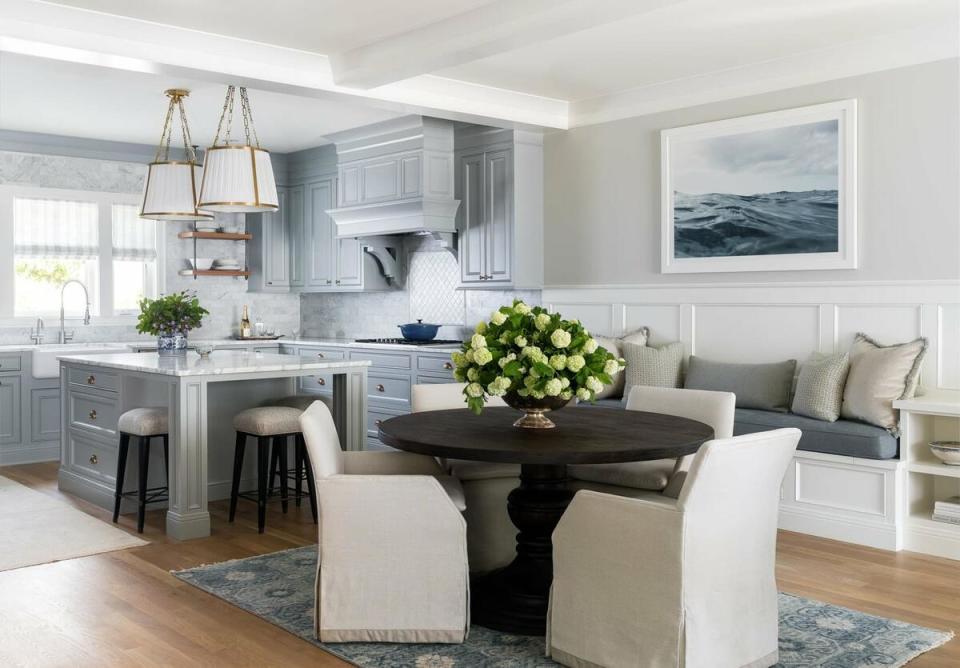
How did you have to approach the business differently once it was your full-time job?
I had to hire somebody to do CAD work for me, and also to assist me on my projects. It quickly flipped from working by myself from my home to hiring employees—and then, once it was four of us working out of two spare bedrooms in my house, [I started] looking for an office space.
What does your team look like today?
Right now, I have three people in my office plus me—I’m the lead on every project, but I have two senior designers to help me, and one production manager who handles the ordering, tracking, pricing, and following each item through the process. And I work with [a contractor] who handles all of my accounting and taxes. I’m licensed in three states, so she handles all of the sales tax and does my payroll.
How many projects are you typically working on?
We typically have 12 or 13 projects, which range in scope from big 8,000-square-foot custom home builds to full renovations and whole-home furnishing jobs. We have projects locally in the Seattle area, but also in Maui, Hawaii; Newport Beach, California; and Rancho Santa Fe, California.
How do you decide what you say yes to?
It’s typically [about the] scale of the project. I wouldn’t just take on a room—I used to do that in the past, but now it needs to be a whole-home project, whether that’s a renovation plus a handful of rooms to furnish or full, ground-up new builds. Budget also comes into play, because I am definitely on the higher end. I don’t specify from big-box stores; it’s all either custom made or I pick the frame from a vendor and it’s all COM; all of our pillows and draperies are custom. I like to have that conversation upfront, because sometimes people don’t know until you tell them, “This is how much I think it will cost to furnish this project.” They either balk at that or they don’t, but I want to give them a realistic number upfront.
I also strive to make sure that the projects that I take on are not just a good fit from a financial standpoint, but also, “Can I work with these people?” I always have a phone screening to talk scope and budget, [and I assess] the personality fit. I don’t meet with anybody in person until I think it could potentially be something.
Is there something specific you’re looking for in that meeting?
Trust is huge. The client has to trust you, and trust that you are looking out for their best interests.
Where does the client see you and where do they interact with your team?
It’s hard for me to delegate. I had somebody doing the ordering for me years ago, and there were just far too many mistakes. I’m a perfectionist, and so I took that role on, and for years I was doing all the ordering myself. It was nuts. It was taking away from me designing my projects. When I finally brought someone on to do that again last year, I was immediately like, “Oh, my God, I should have done this sooner.”
I am the main person that all my clients talk to, but my designers are also on all of the email chains and come to site meetings with me, so they are very aware of the conversations. But I always want my clients to know that I’m always available for them. If they call the office and I’m there, they can talk to me; if I’m not, they can also talk to the girls in the office because they know what’s going on.
What are your boundaries around client communication?
I have a landline at my office. You can’t text a landline! We’re open from 9 to 5 Monday through Friday, and I state that upfront: “These are our office hours. I don’t work nights and weekends.” So, they know that if they’re going to email me at 6 p.m. on a Friday, they’re not going to hear back from me until Monday morning.
How have you approached billing for your work?
We bill hourly. I have tried doing a flat fee in the past and I just lost way too much money, or you have to go back and have another conversation to renegotiate when the project snowballs. I don’t like that, so I bill hourly, and I give clients an estimate of hours when I first talk to them about the project. That way, they have that [estimate] in their mind, and then we bill for the previous month on the first of every month.
I also will give people an estimate upfront about furnishings: “This is where I think you’re going to come in furniture-wise for your project based on what you want to do,” which includes my markup. I am totally comfortable talking about it with a client—I think my sales background helps with that, but you also have to remember that you’re running a business. This is your business. This is how you make money. This is how you support yourself. This is not a hobby. Like, I don’t do this because it’s fun. It is fun, but this is my career.
I think money is a hard topic for a lot of people to talk about. Even the majority of our clients will often say, “Gosh, we don’t know what our budget is,” or “We don’t really have a budget.” OK, [but] are you talking $100,000 or are you talking $1 million?
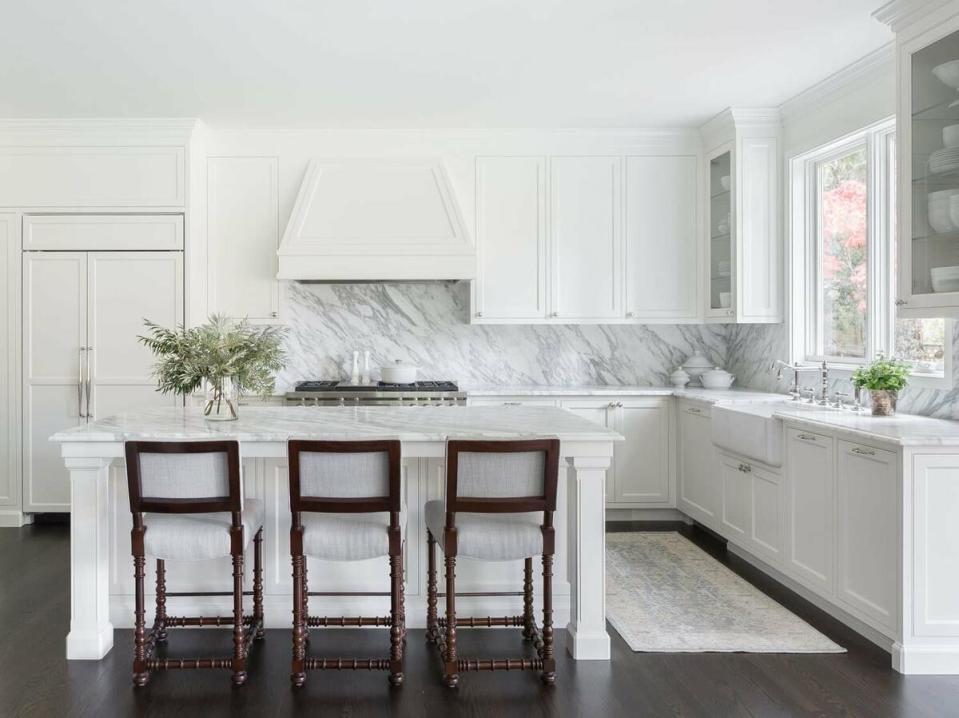
Where do you shop?
We have a small design center here in Seattle, and then I go to the D&D Building in New York. I also travel to France [to source] twice a year—that’s a huge passion of mine. And I shop on 1stDibs and Chairish. Every home needs something antique, you know?
Tell me more about sourcing in France.
It’s my favorite thing—I’m actually going on December 26. I go to the Paris flea markets, and I go down to Provence for antiques markets there [that offer] tremendous pieces for a great price. Now, you will pay a lot to freight it back, but they just have really beautiful things. I have not shipped a container before; I’ve only had things crated.
Are you shopping more generally, or buying with a particular project in mind?
Sometimes I am buying for particular clients—I’ll take pictures and say, “What do you think of this?” and they approve it. Other times, I’ll just buy something because I love it and I know I can find a home for it. I usually say I can shove it in my house somewhere, or it’s going to the storage unit. I don’t buy things where I’m like, “Oh, maybe somebody will like it.” I have to be obsessed with the piece.
We’re actually going to be opening up an online shop and I’m going to be selling some of those things. We’re in the process of putting this up so I can bring back my treasured things from France and share them.
That’s exciting! Will it all be local pickup, or will you handle freight?
We’ll ship across the country. For anything small, we can arrange shipping; for furniture, we would give them a list of preferred shippers and they would be responsible for arranging that. I’ve been doing a summer sale for several years, where we set up a room [in our office] and sell things from France and other found objects. People have asked me to set up an online presence for years, so now that’s the plan. My guess is that it’s going to be more of a trade audience.
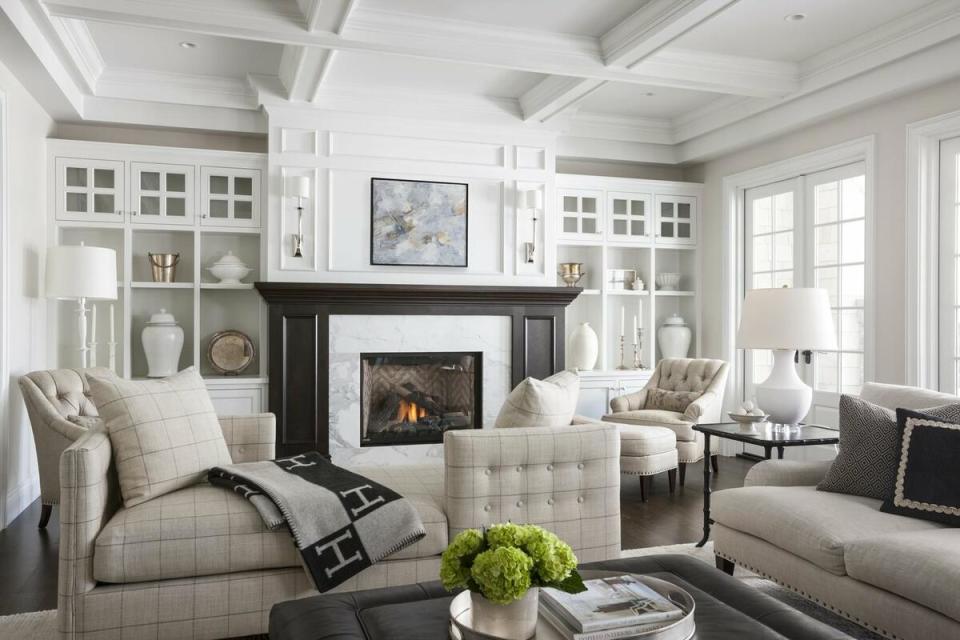
How has the design scene in Washington shaped the opportunities that are available to you?
I’m born and raised in Washington, but I’ve never felt like I’m from here. I always felt like I’m [supposed to be] from the East Coast—that’s the design aesthetic I’m drawn to.
You relocated to the East Coast briefly before the pandemic. Is that what inspired the move to Charleston?
I had been to Charleston before, and I really liked it. I went down there for a factory tour with Urban Electric in 2018, and as I was walking in South of Broad, I was like, “This is the neighborhood I’m going to live in.” I loved the history, the architecture, the smaller size, the friendlier people. While I was on the plane flying back to Seattle, I was on Zillow, and that’s when I found my house. It was built in 1780, and I just knew it was my house. Within a week of getting home, I called a friend who was a real estate agent to put my house on the market, and I flew down to Charleston that same weekend to look at the house there. A month later, the semi truck was in front of my house for my move to Charleston. It happened very fast.
What did you think that would mean for your business?
I had a full-time employee here in Seattle, so she stayed here and I worked in Charleston. I told all of my clients I was moving there, but that I would still be available. I thought I would do the bicoastal thing and travel back and forth. This was pre-pandemic, before Zoom was really a thing. So even though I lived down there and had a few local projects, I was flying back to Seattle for at least a week or more a month. And I realized that a lot of my new projects were still coming from Seattle. It quickly got to the point where I realized that I did need to be on-site here. I ultimately did it for a full year. I moved to Charleston in August 2018, and I sold my house and moved back in August 2019. And since I moved back, I see Seattle through a different lens.
What changed? What is it about leaving and coming back that shifted for you?
I can’t really pinpoint what it was. There’s something about familiarity. There’s something about having relationships and connections in this industry that are really important. I can walk into showrooms and people know who I am, I can walk onto job sites and I’ve worked with either the contractor or architect or tradespeople before, and there’s something invaluable about that in this industry. Having those relationships that you’ve had for years. When I was in Charleston, there was no design center; it was Atlanta, which is like a five-hour drive. So you would rely on reps coming into Charleston meeting with you in a hotel lobby or whatever. Being new to a market like that, nobody knows your history. It’s like you’re starting brand-new. Thankfully, I had a good Instagram following, so I did have clients that hired me when I was there who knew me from Instagram, but otherwise, nobody knows who you are. So, coming back to a market where I’ve been established and have a good reputation and well known, that has been very positive. I need to be here for my business. I can’t imagine moving my business out of state again. I could see myself buying a house somewhere else for a vacation type home, but while I’m in design and not retired, this needs to be my primary residence.
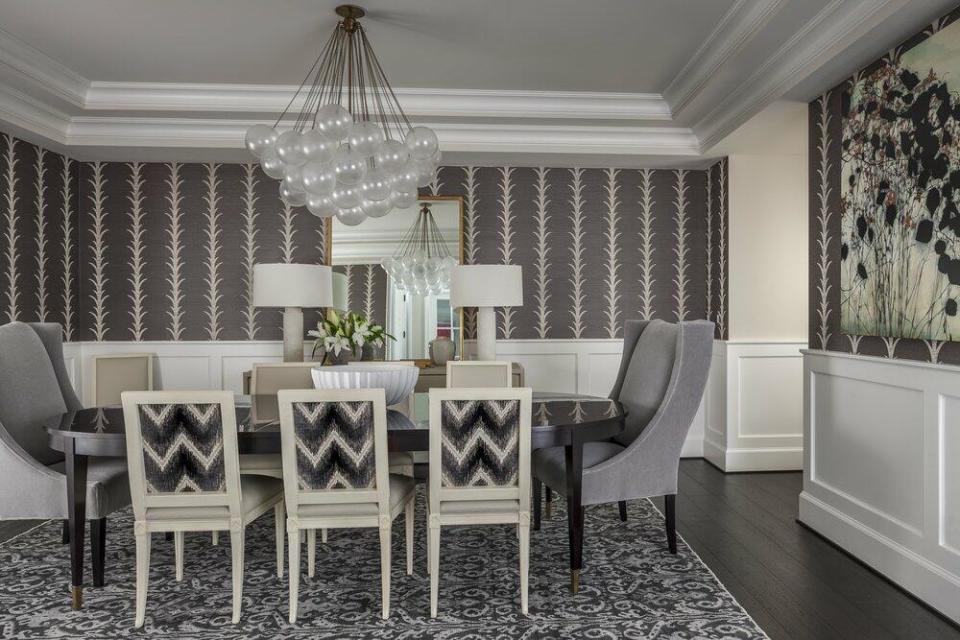
Given that your aesthetic has always leaned more East Coast, how has that worked to your detriment but also to your advantage, having the aesthetic of another place?
I feel like a lot of my clients aren’t from Seattle. They have moved here from other places, or just gravitate toward [a different look]. Northwest style is not for me. I don’t love the architecture here. There are a lot of modern boxes going up, as in any major city. It’s super unattractive. Now, I will say, some are extremely well done, because they’ve spent a lot of money making them extraordinary; that is very rare. But I don’t like midcentury modern, I don’t like anything Northwest or Craftsman homes. I just don’t. There’s nothing wrong with those homes. They’re beautiful in their own right—absolutely not dissing those styles; they’re just not my style. So I’ve been fortunate to, at least on the new construction side, build homes for clients with shingle siding, beautiful millwork on the inside and more classical details. The homes that I work on that are furnishing projects are older homes in Seattle, estate-type properties. Just sort of enriched [by the local] history here. So, I’m grateful that I have clients here that buy those homes and don’t want to tear them down; [they] hire me to spark a new bit of life into them and make them their own and maintain that.
Have you ever taken a project where you tried to bring in your perspective within the limitations of the more modern local architecture?
No, because I don’t take them on—I just pass on the project. I [advise those clients] to stay true to the architecture of the house. Beyond that, I am super transparent with them: You’re going to be spending a lot of money making this your home, and you need to be working with a designer who is really going to capture the aesthetic of your home and who understands that style better than I do.
What does success look like for you today?
I am grateful to have an incredible team of women working under me, a really solid team that I trust implicitly, who show up every day with a mindset to keep things moving. They’re hard workers, they do the job, they’re just phenomenal individuals—that hasn’t always been the case, and I couldn’t be more grateful that it is now. I love the team I have, so that’s success for me.
Also, anytime somebody refers me to a new project, it’s an honor. When somebody has really appreciated what you brought to the table and [that you] made their house beautiful and they are willing to refer you to their friends or colleagues, it’s really rewarding.
To learn more about Marianne Simon, visit her website or find her on Instagram.
Want to stay informed? Sign up for our newsletter, which recaps the week’s stories, and get in-depth industry news and analysis each quarter by subscribing to our print magazine. Join BOH Insider for discounts, workshops and access to special events such as the Future of Home conference.

